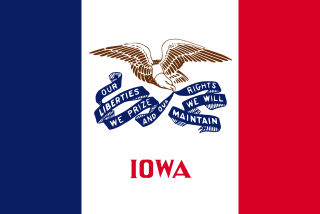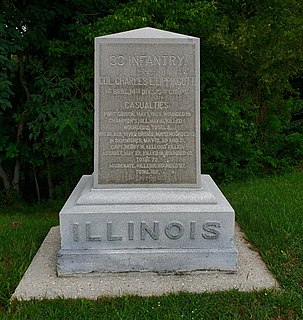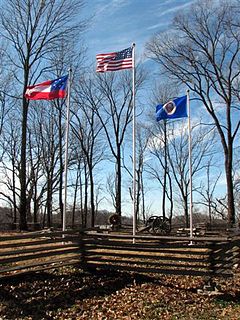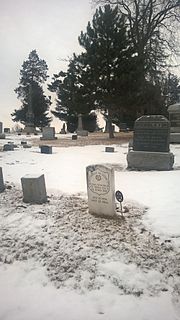Related Research Articles

The siege of Vicksburg was the final major military action in the Vicksburg campaign of the American Civil War. In a series of maneuvers, Union Maj. Gen. Ulysses S. Grant and his Army of the Tennessee crossed the Mississippi River and drove the Confederate Army of Mississippi, led by Lt. Gen. John C. Pemberton, into the defensive lines surrounding the fortress city of Vicksburg, Mississippi.

The Siege of Fort Erie, from 4 August to 21 September 1814, was one of the last engagements of the War of 1812, between British and American forces. It took place during the Niagara campaign, and the Americans successfully defended Fort Erie against a British army. During the siege, the British suffered high casualties in a failed storming attempt; they also suffered casualties from sickness and exposure in their rough encampments. Unaware that the British were about to abandon the siege, the American garrison launched a sortie to destroy the British siege batteries, during which both sides again suffered high losses.

The siege of Corinth was an American Civil War engagement lasting from April 29 to May 30, 1862, in Corinth, Mississippi. A collection of Union forces under the overall command of Major General Henry Halleck engaged in a month-long siege of the city, whose Confederate occupants were commanded by General P.G.T. Beauregard. The siege resulted in the capture of the town by Federal forces.

The 2nd Iowa Infantry Regiment was an infantry regiment that served in the Union Army during the American Civil War.

The 12th Iowa Infantry Regiment was an infantry regiment that served in the Union Army during the American Civil War.
The 21st Iowa Infantry Regiment was an infantry regiment that served in the Union Army during the American Civil War.
The 22nd Iowa Infantry Regiment was an infantry regiment that served in the Union Army during the American Civil War.

The 33rd Illinois Infantry Regiment was an infantry regiment from Illinois that served in the Union Army during the American Civil War. A number of the soldiers were college students and graduates, and for a time the regiment included a 17-piece band. The unit fought at Fredericktown in 1861, Cotton Plant in 1862, the Vicksburg campaign and Fort Esperanza in 1863, and at Spanish Fort in 1865. The original enlistees were mustered out in October 1864 while the veterans and recruits were mustered out in December 1865.

The 114th Illinois Infantry Regiment was an infantry regiment from Illinois that served in the Union Army during the American Civil War. Formed in September 1862, the regiment served in Ulysses S. Grant's Central Mississippi campaign, in the Vicksburg campaign, at Brices Cross Roads, at Tupelo, in the 1864 Missouri campaign, at Nashville, and at Spanish Fort. At Nashville, the unit participated in the decisive attack on Shy's Hill. In 1865, the regiment was reassigned as pontoniers. The regiment was mustered out in August 1865.
The 58th Ohio Infantry Regiment was an infantry regiment in the Union Army during the American Civil War.
The 83rd Ohio Infantry Regiment, sometimes 83rd Ohio Volunteer Infantry was an infantry regiment in the Union Army during the American Civil War. It was nicknamed "The Greyhound Regiment".
The 96th Ohio Infantry Regiment, sometimes 96th Regiment, Ohio Volunteer Infantry was an infantry regiment in the Union Army during the American Civil War.
The 69th Regiment Indiana Infantry was an infantry regiment that served in the Union Army during the American Civil War.

The 113th Regiment Illinois Volunteer Infantry was an infantry regiment in the Union Army during the American Civil War.
The 127th Regiment, Illinois Volunteer Infantry was an infantry regiment in the Union Army during the American Civil War.
The 10th Missouri Infantry Regiment was an infantry regiment that served in the Union Army during the American Civil War.

Leonidas Mahlon Godley was a Union Army soldier during the American Civil War. He received the Medal of Honor for gallantry during the Siege of Vicksburg on May 22, 1863.

The 11th Regiment Illinois Volunteer Infantry was an infantry regiment from Illinois that served in the Union Army during the American Civil War. In April 1861, it was formed as a three-month volunteer unit, and in July 1861 it was reorganized as a three-year unit, in which role it served until the end of the war. Two of its commanding officers were promoted to brigadier general and led major units during the war. In its first major action at Fort Donelson the regiment suffered terrible losses. The 11th Illinois also fought at Shiloh, Riggins Hill, Vicksburg, First Yazoo City, Second Yazoo City, and Fort Blakely. In April 1863, the 109th Illinois Infantry Regiment was disbanded and its enlisted men transferred into the 11th Illinois. The regiment was mustered out of service in July 1865.

The 46th New York Infantry Regiment was an infantry regiment in the Union Army during the American Civil War.
The 1st and 4th Missouri Infantry (Consolidated) was an infantry regiment that served in the Confederate States Army during the American Civil War. The regiment was formed on November 7, 1862 when the 1st Missouri Infantry and the 4th Missouri Infantry were consolidated as a result of heavy battle losses in both units. The regiment served in several battles in the 1863 Vicksburg campaign, including a charge that almost broke the Union line at the Battle of Champion Hill. When the Siege of Vicksburg ended with a Confederate surrender, the regiment was captured and later exchanged. In 1864, the regiment fought in the Atlanta campaign, and suffered heavy losses at the Battle of Franklin. On April 9, 1865, the regiment surrendered at the Battle of Fort Blakely, and was paroled in May when the war ended for all effective purposes.
References
- ↑
- Roster and Record of Iowa Soldiers in the War of the Rebellion, Vol. III, pg. 564./http://iagenweb.org/civilwar/books/logan/mil506.htm
- ↑ Vanishing Footprints, The Twenty-Second Iowa Volunteer Infantry in the Civil War by Samuel D. Pryce, Edited by Jeffry C. Burden, Camp Pope Bookshop 2008, page 126./http://www.camppope.com/pryce.html
- ↑ Grundy County Heritage Museum /http://www.northernsunprint.com/page/content.detail/id/502900/Leonidas-Mahlon-Godley---Iowa-Medal-of-Honor---Civil-War-By--Sue-Eckhoff--Grundy-County-Heritage-Museum.html?nav=5000#sthash.5LhkUlOT.dpuf
- ↑ Congressional Medal of Honor Society /http://www.cmohs.org/recipient-detail/502/godley-leonidas-m.php